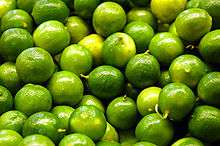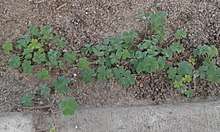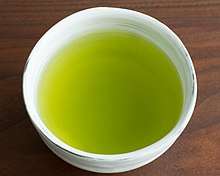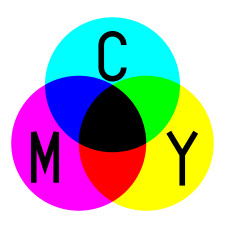Shades of green
Varieties of the color green may differ in hue, chroma (also called saturation or intensity) or lightness (or value, tone, or brightness), or in two or three of these qualities. Variations in value are also called tints and shades, a tint being a green or other hue mixed with white, a shade being mixed with black. A large selection of these various colors is shown below.
%2C_Cozumel.jpg)
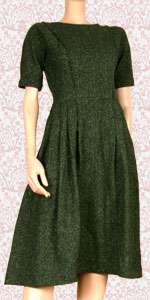
_3.jpg)

| Green | |
|---|---|
| Spectral coordinates | |
| Wavelength | 520–570 nm |
| Frequency | ~526–577 THz |
| sRGBB (r, g, b) | (0, 128, 0) |
| HSV (h, s, v) | (120°, 100%, 50%) |
| Source | W3C TR CSS3 Color Module[1] |
| B: Normalized to [0–255] (byte) | |
| Some tints and shades of green | |
Green in biological nature
Green is common in nature, especially in plants. Many plants are green mainly because of a complex chemical known as chlorophyll which is involved in photosynthesis.[2] Many shades of green have been named after plants or are related to plants. Due to varying ratios of chlorophylls (and different amounts as well as other plant pigments being present), the plant kingdom exhibits many shades of green in both hue (true color) and value (lightness/darkness). The chlorophylls in living plants have distinctive green colors, while dried or cooked portions of plants are different shades of green due to the chlorophyll molecules losing their inner magnesium ion.
Artichoke
| Artichoke | |
|---|---|
| Hex triplet | #8F9779 |
| sRGBB (r, g, b) | (143, 151, 121) |
| CMYKH (c, m, y, k) | (5, 0, 20, 41) |
| HSV (h, s, v) | (76°, 20%, 59%) |
| Source | ISCC-NBS[3][4] |
| ISCC–NBS descriptor | Moderate yellow green |
| B: Normalized to [0–255] (byte) H: Normalized to [0–100] (hundred) | |
Artichoke is a color that is a representation of the color of a raw fresh uncooked artichoke. Another name for this color is artichoke green.

The first recorded use of "artichoke green" as a color name in English was in 1905.[5]
Artichoke green (Pantone)
| Artichoke green (Pantone) | |
|---|---|
| Hex triplet | #4B6F44 |
| sRGBB (r, g, b) | (75, 111, 68) |
| HSV (h, s, v) | (110°, 39%, 44%) |
| Source | Pantone[6] |
| ISCC–NBS descriptor | Dark yellowish green |
| B: Normalized to [0–255] (byte) | |
This is the color called artichoke green in Pantone. The source is Pantone 18-0125 TPX.[6]
Asparagus
| Asparagus | |
|---|---|
| Hex triplet | #87A96B |
| sRGBB (r, g, b) | (135, 169, 107) |
| CMYKH (c, m, y, k) | (20, 0, 37, 34) |
| HSV (h, s, v) | (93°, 37%, 66%) |
| Source | Crayola |
| ISCC–NBS descriptor | Moderate yellow green |
| B: Normalized to [0–255] (byte) H: Normalized to [0–100] (hundred) | |
Asparagus is a tone of green that is named after the vegetable. Crayola created this color in 1993 as one of the 16 to be named in the Name the Color Contest.
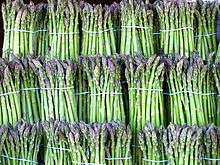
It is also the color of a wild asparagus plant blowing in the wind of the 1949 classic film Sands of Iwo Jima.
Another name for this color is asparagus green. The first recorded use of "asparagus green" as a color name in English was in 1805.[7]
Avocado
| Avocado | |
|---|---|
| Hex triplet | #568203 |
| sRGBB (r, g, b) | (86, 130, 3) |
| CMYKH (c, m, y, k) | (34, 0, 98, 49) |
| HSV (h, s, v) | (81°, 98%, 51%) |
| Source | Pourpre.com[8] |
| ISCC–NBS descriptor | Deep yellow green |
| B: Normalized to [0–255] (byte) H: Normalized to [0–100] (hundred) | |
Avocado is a color that is a representation of the color of the outer surface of an avocado.

The color avocado is a dark yellow-green color.
Avocado was a common color for metal surfaces (including automobiles and household appliances), as well as the color harvest gold, during the whole decade of the 1970s. They were both also popular colors for shag carpets. Both colors went out of style by the early 1980s.
Fern green
| Fern green | |
|---|---|
| Hex triplet | #4F7942 |
| sRGBB (r, g, b) | (79, 121, 66) |
| CMYKH (c, m, y, k) | (71, 32, 90, 18) |
| HSV (h, s, v) | (106°, 45%, 47%) |
| Source | Maerz and Paul[9] |
| ISCC–NBS descriptor | Dark yellowish green |
| B: Normalized to [0–255] (byte) H: Normalized to [0–100] (hundred) | |
| Fern | |
|---|---|
| Hex triplet | #71BC78 |
| sRGBB (r, g, b) | (113, 188, 120) |
| CMYKH (c, m, y, k) | (40, 0, 36, 26) |
| HSV (h, s, v) | (126°, 40%, 74%) |
| Source | Crayola |
| ISCC–NBS descriptor | Brilliant yellowish green |
| B: Normalized to [0–255] (byte) H: Normalized to [0–100] (hundred) | |
Fern green is a color that resembles ferns. A Crayola crayon named fern was created in 1998, which is a lighter shade of the top color shown on the right.
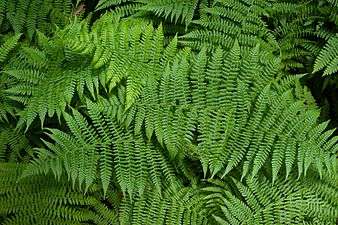
The first recorded use of fern green as a color name in English was in 1902.[10]
Forest green
| Forest green | |
|---|---|
| Hex triplet | #228B22 |
| sRGBB (r, g, b) | (34, 139, 34) |
| CMYKH (c, m, y, k) | (100, 50, 100, 50) |
| HSV (h, s, v) | (120°, 76%, 55%) |
| Source | X11 |
| ISCC–NBS descriptor | Vivid yellowish green |
| B: Normalized to [0–255] (byte) H: Normalized to [0–100] (hundred) | |
Forest green refers to a green color said to resemble the color of the trees and other plants in a forest.[11]
The first recorded use of forest green as the name of a color in the English language was in 1810.[12]
Jungle green
| Jungle green | |
|---|---|
| Hex triplet | #29AB87 |
| sRGBB (r, g, b) | (41, 171, 135) |
| CMYKH (c, m, y, k) | (50, 0, 50, 2) |
| HSV (h, s, v) | (120°, 80%, 70%) |
| Source | Crayola |
| ISCC–NBS descriptor | Brilliant green |
| B: Normalized to [0–255] (byte) H: Normalized to [0–100] (hundred) | |
Displayed at right is the color jungle green. In 1990, Crayola named and formulated this specific tone of jungle green.
The first recorded use of jungle green as a name of a color in the English language was in 1926.[13]
Laurel green
| Laurel green | |
|---|---|
| Hex triplet | #A9BA9D |
| sRGBB (r, g, b) | (169, 186, 157) |
| CMYKH (c, m, y, k) | (9, 0, 16, 27) |
| HSV (h, s, v) | (95°, 16%, 73%) |
| Source | Maerz and Paul[14] |
| ISCC–NBS descriptor | Moderate yellow green |
| B: Normalized to [0–255] (byte) H: Normalized to [0–100] (hundred) | |
Laurel green is a medium light hue of greenish gray similar to asparagus, but lighter.
The first recorded use of laurel green as a name of a color in the English language was in 1705.[15]
Lime
| Lime | |
|---|---|
| Hex triplet | #BFFF00 |
| sRGBB (r, g, b) | (192, 255, 0) |
| CMYKH (c, m, y, k) | (25, 0, 100, 0) |
| HSV (h, s, v) | (75°, 100%, 100%) |
| Source | Maerz and Paul[16][17] |
| ISCC–NBS descriptor | Vivid yellow green |
| B: Normalized to [0–255] (byte) H: Normalized to [0–100] (hundred) | |
Lime is a shade of green, so named because it is a representation of the color of the citrus fruit called limes. It is the color that is in between the web color chartreuse and yellow on the color wheel.[16]
Mantis
| Mantis | |
|---|---|
| Hex triplet | #74C365 |
| sRGBB (r, g, b) | (116, 195, 101) |
| CMYKH (c, m, y, k) | (41, 0, 48, 24) |
| HSV (h, s, v) | (110°, 48%, 77%) |
| Source | Xona.com color list |
| ISCC–NBS descriptor | Brilliant yellowish green |
| B: Normalized to [0–255] (byte) H: Normalized to [0–100] (hundred) | |
Mantis is a color that is a representation of the color of a praying mantis.

The first use of mantis as a color name in English was when it was included as one of the colors on the Xona.com color list, promulgated in 2001.
Mint
| Mint | |
|---|---|
| Hex triplet | #3EB489 |
| sRGBB (r, g, b) | (62, 180, 137) |
| CMYKH (c, m, y, k) | (66, 0, 24, 29) |
| HSV (h, s, v) | (158°, 66%, 71%) |
| Source | ISCC-NBS[18][19] |
| ISCC–NBS descriptor | Brilliant green |
| B: Normalized to [0–255] (byte) H: Normalized to [0–100] (hundred) | |
The color mint, also known as mint leaf, is a representation of the color of mint.[20]
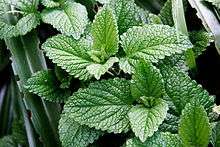
The first recorded use of mint as a color name in English was in 1920.[21]
Moss green
| Moss green | |
|---|---|
| Hex triplet | #8A9A5B |
| sRGBB (r, g, b) | (138, 154, 91) |
| CMYKH (c, m, y, k) | (10, 0, 41, 40) |
| HSV (h, s, v) | (75°, 41%, 60%) |
| Source | ISCC-NBS[18][22] |
| ISCC–NBS descriptor | Moderate yellow green |
| B: Normalized to [0–255] (byte) H: Normalized to [0–100] (hundred) | |
Moss green is a tone of green that resembles moss.
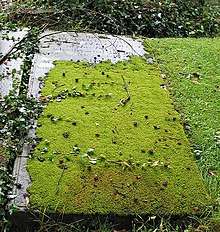
The first recorded use of moss green as a color name in English was in 1884.[23]
Dark moss green
| Dark moss green | |
|---|---|
| Hex triplet | #4A5D23 |
| sRGBB (r, g, b) | (74, 93, 35) |
| CMYKH (c, m, y, k) | (20, 0, 62, 64) |
| HSV (h, s, v) | (80°, 62%, 36%) |
| Source | Encycolorpedia[24] |
| ISCC–NBS descriptor | Moderate olive green |
| B: Normalized to [0–255] (byte) H: Normalized to [0–100] (hundred) | |
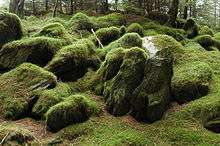
Myrtle green
| Myrtle green | |
|---|---|
| Hex triplet | #317873 |
| sRGBB (r, g, b) | (49, 120, 115) |
| CMYKH (c, m, y, k) | (59, 0, 4, 53) |
| HSV (h, s, v) | (176°, 59%, 47%) |
| Source | ISCC-NBS[18][25] |
| ISCC–NBS descriptor | Moderate bluish green |
| B: Normalized to [0–255] (byte) H: Normalized to [0–100] (hundred) | |
Myrtle green, also called myrtle, is a color which is a representation of the color of the leaves of the myrtle plant.
The first recorded use of myrtle green as a color name in English was in 1835.[26]
Myrtle is the official designation of the green stripes on Waterloo rugby club's shirts, the green of Hunslet rugby league club, the green (along with the cardinal red) stripes of the South Sydney Rabbitohs and the green of the blazers, sports kit and scarf of St. Aloysius' College, Glasgow. It is also one of the school colors of Lane Technical College Prep High School in Chicago, the other being old gold.
The baggy green, the cricket cap worn by Australian Test cricketers since around the turn of the twentieth century, is myrtle green in color.
Pine green
| Pine green | |
|---|---|
| Hex triplet | #01796F |
| sRGBB (r, g, b) | (1, 121, 111) |
| CMYKH (c, m, y, k) | (99, 0, 8, 53) |
| HSV (h, s, v) | (175°, 99%, 47%) |
| Source | Crayola |
| ISCC–NBS descriptor | Moderate bluish green |
| B: Normalized to [0–255] (byte) H: Normalized to [0–100] (hundred) | |
Pine green is a rich shade of spring green that resembles the color of pine trees. It is an official Crayola color (since 1903).
.jpg)
The first recorded use of pine tree as a color name in English was in 1923.[27]
Reseda green
| Reseda green | |
|---|---|
| Hex triplet | #6C7C59 |
| sRGBB (r, g, b) | (108, 124, 89) |
| CMYKH (c, m, y, k) | (13, 0, 28, 51) |
| HSV (h, s, v) | (87°, 28%, 49%) |
| Source | [Unsourced] |
| ISCC–NBS descriptor | Moderate olive green |
| B: Normalized to [0–255] (byte) H: Normalized to [0–100] (hundred) | |
Reseda green is a shade of greyish green in the classic range of colors of the German RAL colour standard, in which it is named "RAL 6011".[28]
.jpg)
The name derives from the color of the leaves of Reseda odorata, commonly known as mignonette.[29]
Sap green
Sap green is a green pigment that was traditionally made of ripe buckthorn berries.[30] However, modern colors marketed under this name are usually a blend of other pigments, commonly with a basis of Phthalocyanine Green G.[31] Sap green paint was frequently used on Bob Ross' TV show, The Joy of Painting.[32]
Shamrock green (Irish green)
| Shamrock green | |
|---|---|
| Common connotations | |
| St. Patrick's Day | |
| Hex triplet | #009E60 |
| sRGBB (r, g, b) | (0, 158, 96) |
| CMYKH (c, m, y, k) | (100, 0, 86, 3) |
| HSV (h, s, v) | (156°, 100%, 62%) |
| Source | Maerz and Paul[33] |
| ISCC–NBS descriptor | Strong yellowish green |
| B: Normalized to [0–255] (byte) H: Normalized to [0–100] (hundred) | |
Shamrock green is a tone of green that represents the color of shamrocks, a symbol of Ireland.[34]
The first recorded use of shamrock as a color name in English was in the 1820s (exact year uncertain).[35]
This green is also defined as Irish green Pantone 347.[36]
This green is used as the green on the national flag of the Republic of Ireland[37]
It is customary in Ireland, Australia, New Zealand, Canada, and the United States to wear this or any other tone of green on St. Patrick's Day, 17 March.
The State of California uses this shade of green of the grass under the bear on their state flag.[38]
The Boston Celtics of the National Basketball Association use this shade for their uniforms, logos, and other memorabilia.
Tea green
| Tea green | |
|---|---|
| Hex triplet | #D0F0C0 |
| sRGBB (r, g, b) | (208, 240, 192) |
| CMYKH (c, m, y, k) | (13, 0, 20, 6) |
| HSV (h, s, v) | (100°, 20%, 94%) |
| Source | Encycolorpedia[39] |
| ISCC–NBS descriptor | Very light yellowish green |
| B: Normalized to [0–255] (byte) H: Normalized to [0–100] (hundred) | |
Tea green is a light shade of green. It is a representation of the color of brewed green tea, i.e., the color of the hot green tea after the green tea leaves have been brewed in boiling water.[40]
The first recorded use of tea green as a color name in English was in 1858.[41]
Teal
| Teal | |
|---|---|
| Hex triplet | #008080 |
| sRGBB (r, g, b) | (0, 128, 128) |
| CMYKH (c, m, y, k) | (100, 0, 0, 50) |
| HSV (h, s, v) | (180°, 100%, 50%) |
| Source | HTML/CSS[1] |
| ISCC–NBS descriptor | Moderate bluish green |
| B: Normalized to [0–255] (byte) H: Normalized to [0–100] (hundred) | |
Teal is displayed at right. It is a dark cyan color that is a representation of the color of the neck coloring of a duck called the common teal.
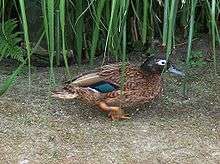
Olive
| Olive | |
|---|---|
| Hex triplet | #808000 |
| sRGBB (r, g, b) | (128, 128, 0) |
| CMYKH (c, m, y, k) | (0, 0, 100, 50) |
| HSV (h, s, v) | (60°, 100%, 50%) |
| Source | X11 color names[19] |
| ISCC–NBS descriptor | Light olive |
| B: Normalized to [0–255] (byte) H: Normalized to [0–100] (hundred) | |
Olive is the shade of dark yellow-green found on green olives. It has been commonly used by militaries around the world as a color for uniforms and equipment.

Green in non-biological nature
Emerald
green |
emerald |
viridian |
| Emerald | |
|---|---|
| Hex triplet | #50C878 |
| sRGBB (r, g, b) | (80, 200, 120) |
| CMYKH (c, m, y, k) | (60, 0, 40, 22) |
| HSV (h, s, v) | (140°, 60%, 78%) |
| Source | Maerz and Paul[42] |
| ISCC–NBS descriptor | Vivid yellowish green |
| B: Normalized to [0–255] (byte) H: Normalized to [0–100] (hundred) | |
Emerald, also called emerald green, is a tone of green that is particularly light and bright, with a faint bluish cast. The name derives from the typical appearance of the emerald gemstone.[43]
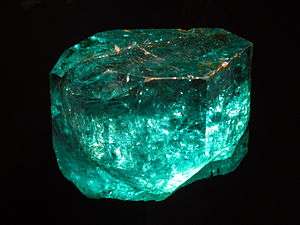
The first recorded use of emerald as a color name in English was in 1598.[44]
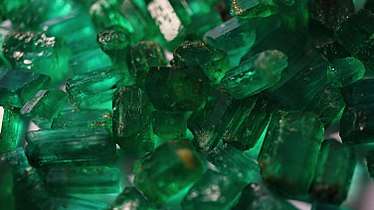
Ireland is sometimes referred to as the Emerald Isle due to its lush greenery. The May birthstone is emerald. Seattle is sometimes referred to as the Emerald City, because its abundant rainfall creates lush vegetation. In the Middle Ages, The Emerald Tablet of Hermes Trismegistus was believed to contain the secrets of alchemy. "Emerald City", from the story of The Wonderful Wizard of Oz, by L. Frank Baum, is a city where everything from food to people are emerald green. However, it is revealed at the end of the story that everything in the city is normal colored, but the glasses everyone wears are emerald tinted. The Green Zone in Baghdad is sometimes ironically and cynically referred to as the Emerald City.[45] The Emerald Buddha is a figurine of the sitting Buddha, made of green jade (rather than emerald), clothed in gold, and about 45 cm tall. It is kept in the Chapel of the Emerald Buddha (Wat Phra Kaew) on the grounds of the Grand Palace in Bangkok. The Emerald Triangle refers to the three counties of Mendocino, Humboldt, and Trinity in Northern California, United States[46] because these three counties are the biggest marijuana producing counties in California and also the US.[46] A county-commissioned study reports pot accounts for up to two-thirds of the economy of Mendocino.[46] Emerald Cities: Urban Sustainability and Economic Development is a book published in 2010 by Joan Fitzgerald, director of the law, policy and society program at Northeastern University, about ecologically sustainable city planning.
Emerald was invented in Germany in 1814. By taking acetic acid, mixing and boiling it with vinegar, and then by adding some arsenic, a bright blue-green hue was formed.[47] During the 19th century, the arsenic-containing dye Paris green was marketed as emerald green.[48] It was notorious for causing deaths due to it being a popular color used for wallpaper. Victorian women used this bright color for dresses, and florists used it on fake flowers.[49]
Green earth
| Green earth | |
|---|---|
| Hex triplet | #DADD98 |
| sRGBB (r, g, b) | (218, 221, 152) |
| CMYKH (c, m, y, k) | (1, 0, 31, 13) |
| HSV (h, s, v) | (63°, 31%, 87%) |
| Source | Derwent[50] |
| ISCC–NBS descriptor | Light yellow green |
| B: Normalized to [0–255] (byte) H: Normalized to [0–100] (hundred) | |
Displayed at right is the color green earth. It is also known as terre verte and Verona green. It is an inorganic pigment derived from the minerals celadonite and glauconite.[51][52]
Hooker's green
| Hooker's green | |
|---|---|
| Hex triplet | #49796B |
| sRGBB (r, g, b) | (73, 121, 107) |
| CMYKH (c, m, y, k) | (73, 36, 59, 15) |
| HSV (h, s, v) | (163°, 39.7%, 47.5%) |
| Source | Winsor & Newton[53] |
| ISCC–NBS descriptor | Moderate green |
| B: Normalized to [0–255] (byte) H: Normalized to [0–100] (hundred) | |
Hooker's green is a dark green color created by mixing Prussian blue and gamboge. It is displayed on the right. Hooker's green takes its name from botanical artist William Hooker (1779–1832) who first created it particularly for illustrating leaves.[54]
Jade
| Jade | |
|---|---|
| Hex triplet | #00A86B |
| sRGBB (r, g, b) | (0, 168, 107) |
| CMYKH (c, m, y, k) | (100, 0, 36, 34) |
| HSV (h, s, v) | (158°, 100%, 66%) |
| Source | [Unsourced] |
| ISCC–NBS descriptor | Strong yellowish green |
| B: Normalized to [0–255] (byte) H: Normalized to [0–100] (hundred) | |
Jade, also called jade green, is a representation of the color of the gemstone called jade, although the stone itself varies widely in hue.
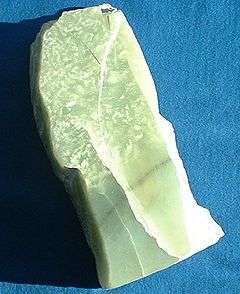
The color name jade green was first used in Spanish in the form piedra de ijada in 1569.[55] The first recorded use of jade green as a color name in English was in 1892.[56]
Malachite
| Malachite | |
|---|---|
| Hex triplet | #0BDA51 |
| sRGBB (r, g, b) | (11, 218, 81) |
| CMYKH (c, m, y, k) | (60, 0, 40, 22) |
| HSV (h, s, v) | (140°, 95%, 85%) |
| Source | Maerz and Paul[57] |
| ISCC–NBS descriptor | Vivid yellowish green |
| B: Normalized to [0–255] (byte) H: Normalized to [0–100] (hundred) | |
Malachite, also called malachite green, is a color that is a representation of the color of the mineral malachite.
The first recorded use of malachite green as a color name in English was in the 1200s (exact year uncertain).[58]
Sea green
| Sea green | |
|---|---|
| Hex triplet | #2E8B57 |
| sRGBB (r, g, b) | (46, 139, 87) |
| CMYKH (c, m, y, k) | (81, 21, 83, 7) |
| HSV (h, s, v) | (146°, 67%, 55%) |
| Source | HTML/CSS |
| ISCC–NBS descriptor | Strong yellowish green |
| B: Normalized to [0–255] (byte) H: Normalized to [0–100] (hundred) | |
Sea green is a color that resembles the hue of shallow seawater as seen from the surface.
.jpg)
Computer web color greens
Green
| Green (X11, color wheel) | |
|---|---|
| Hex triplet | #00FF00 |
| sRGBB (r, g, b) | (0, 255, 0) |
| HSV (h, s, v) | (120°, 100%, 100%) |
| Source | X11 color names,[59] HTML/CSS[1] |
| ISCC–NBS descriptor | Vivid yellowish green |
| B: Normalized to [0–255] (byte) | |
The color defined as green in the RGB color model, displayed on the right, is the brightest possible green that can be reproduced on a computer screen, and is the color named green in X11. It is one of the three primary colors used in the RGB color space along with red and blue. The three additive primaries in the RGB color system are the three colors of light chosen such as to provide the maximum range of colors that are capable of being represented on a computer or television set.
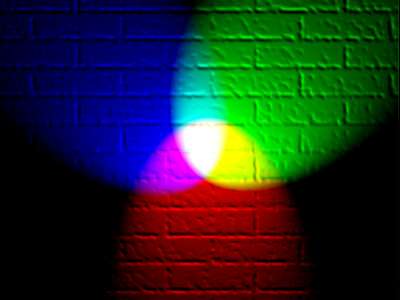
This color is also called regular green. It is at precisely 120 degrees on the HSV color wheel, also known as the RGB color wheel (Image of RGB color wheel). Its complementary color is magenta.
HTML/CSS uses the name lime for this color, using green to refer to a darker shade, shown below. See the chart Color names that clash between X11 and HTML/CSS in the X11 color names article to see those colors which are different in HTML and X11.
Green takes up a large portion of the CIE chromaticity diagram because it is in the central area of human color perception.
Green (HTML/CSS color)
| Green (HTML/CSS color) | |
|---|---|
| Hex triplet | #008000 |
| sRGBB (r, g, b) | (0, 128, 0) |
| CMYKH (c, m, y, k) | (100, 0, 100, 50) |
| HSV (h, s, v) | (120°, 100%, 50%) |
| Source | HTML/CSS[1] |
| ISCC–NBS descriptor | Deep yellowish green |
| B: Normalized to [0–255] (byte) H: Normalized to [0–100] (hundred) | |
The color defined as green in HTML/CSS color standard is displayed at right. It is the color called green, low green, or medium green in many of the older eight-bit computer palettes.
Another name for this color is green W3C or office green.
Dark green (X11)
| Dark green (X11) | |
|---|---|
| Hex triplet | #006400 |
| sRGBB (r, g, b) | (0, 100, 0) |
| CMYKH (c, m, y, k) | (100, 0, 100, 61) |
| HSV (h, s, v) | (120°, 100%, 39.2%) |
| Source | X11[1] |
| ISCC–NBS descriptor | Deep yellowish green |
| B: Normalized to [0–255] (byte) H: Normalized to [0–100] (hundred) | |
This is the X11/HTML color dark green.
Light green
| Light green | |
|---|---|
| Hex triplet | #90EE90 |
| sRGBB (r, g, b) | (144, 238, 144) |
| CMYKH (c, m, y, k) | (40, 0, 40, 7) |
| HSV (h, s, v) | (120°, 39%, 93%) |
| Source | X11[1] |
| ISCC–NBS descriptor | Brilliant yellowish green |
| B: Normalized to [0–255] (byte) H: Normalized to [0–100] (hundred) | |
Light green is a light tint of green.
Lime green
| Lime Green | |
|---|---|
| Hex triplet | #32CD32 |
| sRGBB (r, g, b) | (50, 205, 50) |
| CMYKH (c, m, y, k) | (76, 0, 76, 20) |
| HSV (h, s, v) | (120°, 76%, 80%) |
| Source | X11[60] |
| ISCC–NBS descriptor | Vivid yellowish green |
| B: Normalized to [0–255] (byte) H: Normalized to [0–100] (hundred) | |
The web color "lime green" is displayed at right.
Pale green
| Pale green | |
|---|---|
| Hex triplet | #98FB98 |
| sRGBB (r, g, b) | (152, 251, 152) |
| CMYKH (c, m, y, k) | (39, 0, 39, 2) |
| HSV (h, s, v) | (120°, 39%, 98%) |
| Source | X11[1] |
| ISCC–NBS descriptor | Vivid yellowish green |
| B: Normalized to [0–255] (byte) H: Normalized to [0–100] (hundred) | |
This is the X11/HTML color pale green.
Additional definitions of green
Green (CMYK) (pigment green)
| Green (CMYK) (pigment green) | |
|---|---|
| Hex triplet | #00A550 |
| sRGBB (r, g, b) | (0, 165, 80) |
| CMYKH (c, m, y, k) | (100, 0, 52, 35) |
| HSV (h, s, v) | (149°, 100%, 65%) |
| Source | CMYK[61] |
| ISCC–NBS descriptor | Vivid yellowish green |
| B: Normalized to [0–255] (byte) H: Normalized to [0–100] (hundred) | |
The color defined as green in the CMYK color system used in printing, also known as pigment green, is the tone of green that is achieved by mixing process (printer's) cyan and process (printer's) yellow in equal proportions. It is displayed at right.
The purpose of the CMYK color system is to provide the maximum possible gamut of color reproducible in printing.
The color indicated is only approximate as the colors of printing inks may vary.
Green (NCS) (psychological primary green)
| Green (NCS) | |
|---|---|
| Hex triplet | #009F6B |
| sRGBB (r, g, b) | (0, 159, 107) |
| CMYKH (c, m, y, k) | (100, 0, 33, 38) |
| HSV (h, s, v) | (160°, 100%, 63%) |
| Source | sRGB approximation to NCS 2060-G[62] |
| ISCC–NBS descriptor | Strong yellowish green |
| B: Normalized to [0–255] (byte) H: Normalized to [0–100] (hundred) | |
The color defined as green in the NCS or Natural Color System is shown at right (NCS 2060-G). The natural color system is a color system based on the four unique hues or psychological primary colors red, yellow, green, and blue. The NCS is based on the opponent process theory of vision.
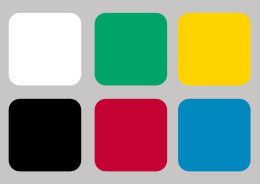
The Natural Color System is widely used in Scandinavia.
Green (Munsell)
| Green (Munsell) | |
|---|---|
| Hex triplet | #00A877 |
| sRGBB (r, g, b) | (0, 168, 119) |
| CMYKH (c, m, y, k) | (100, 0, 29, 54) |
| HSV (h, s, v) | (163°, 100%, 66%) |
| Source | Munsell Color Wheel[63] |
| ISCC–NBS descriptor | Brilliant green |
| B: Normalized to [0–255] (byte) H: Normalized to [0–100] (hundred) | |
The color defined as green in the Munsell color system (Munsell 5G) is shown at right. The Munsell color system is a color space that specifies colors based on three color dimensions: hue, value (lightness), and chroma (color purity), spaced uniformly in three dimensions in the elongated oval at an angle shaped Munsell color solid according to the logarithmic scale which governs human perception. In order for all the colors to be spaced uniformly, it was found necessary to use a color wheel with five primary colors—red, yellow, green, blue, and purple.

The Munsell colors displayed are only approximate as they have been adjusted to fit into the sRGB gamut.
Green (Pantone)
| Green (Pantone) | |
|---|---|
| Hex triplet | #00AD83 |
| sRGBB (r, g, b) | (0, 173, 131) |
| CMYKH (c, m, y, k) | (100, 0, 24, 32) |
| HSV (h, s, v) | (165°, 100%, 68%) |
| Source | Pantone TPX[64] |
| ISCC–NBS descriptor | Brilliant green |
| B: Normalized to [0–255] (byte) H: Normalized to [0–100] (hundred) | |
Green (Pantone) is the color that is called green in Pantone.
The source of this color is the "Pantone Textile Paper eXtended (TPX)" color list, color # green C, EC, HC, PC, U, or UP—green.[64]
Green (Crayola)
| Green (Crayola) | |
|---|---|
| Hex triplet | #1CAC78 |
| sRGBB (r, g, b) | (28, 172, 120) |
| CMYKH (c, m, y, k) | (84, 0, 30, 32) |
| HSV (h, s, v) | (158°, 84%, 68%) |
| Source | Crayola |
| ISCC–NBS descriptor | Strong yellowish green |
| B: Normalized to [0–255] (byte) H: Normalized to [0–100] (hundred) | |
Green (Crayola) is the color called green in Crayola crayons.
Green was one of the original Crayola crayons introduced in 1903.
Bright green
| Bright green | |
|---|---|
| Hex triplet | #66FF00 |
| sRGBB (r, g, b) | (102, 255, 0) |
| CMYKH (c, m, y, k) | (60, 0, 100, 0) |
| HSV (h, s, v) | (96°, 100%, 100%) |
| Source | Hexcode Color Chart[65] |
| ISCC–NBS descriptor | Vivid yellowish green |
| B: Normalized to [0–255] (byte) H: Normalized to [0–100] (hundred) | |
Displayed on the right is the color bright green. Bright green is a bright shade of green. It is on the color wheel approximately one-third of the way between chartreuse green and harlequin (color #3FFF00) (closer to chartreuse green than to harlequin). Bright green represents a visual stimulus of 556 nanometers on the visual spectrum as measured on the CIE chromaticity diagram. The X11 color green is somewhat similar to bright green, with a hex triplet of #00FF00, compared to bright green's triplet of #66FF00.
The color bright green is used to represent bright green environmentalism[66] or the Viridian design movement.
Bright mint
| Bright mint | |
|---|---|
| Hex triplet | #4FFFB0 |
| sRGBB (r, g, b) | (79, 255, 176) |
| CMYKH (c, m, y, k) | (69, 0, 31, 0) |
| HSV (h, s, v) | (153°, 68%, 100%) |
| Source | [Unsourced] |
| ISCC–NBS descriptor | Vivid yellowish green |
| B: Normalized to [0–255] (byte) H: Normalized to [0–100] (hundred) | |
Displayed at right is the color bright mint.
Dark green
| Dark green | |
|---|---|
| Hex triplet | #013220 |
| sRGBB (r, g, b) | (1, 50, 32) |
| CMYKH (c, m, y, k) | (98, 0, 36, 80) |
| HSV (h, s, v) | (158°, 98%, 20%) |
| Source | Encycolorpedia[67] |
| ISCC–NBS descriptor | Very dark yellowish green |
| B: Normalized to [0–255] (byte) H: Normalized to [0–100] (hundred) | |
Dark green is a dark shade of green. A different shade of green has been designated as "dark green (X11)" for certain computer uses.
Dark pastel green
| Dark pastel green | |
|---|---|
| Hex triplet | #03C03C |
| sRGBB (r, g, b) | (3, 192, 60) |
| CMYKH (c, m, y, k) | (98, 0, 69, 25) |
| HSV (h, s, v) | (138°, 98%, 75%) |
| Source | Encycolorpedia[68] |
| ISCC–NBS descriptor | Vivid yellowish green |
| B: Normalized to [0–255] (byte) H: Normalized to [0–100] (hundred) | |
To the right is the color dark pastel green.
Erin
| Erin | |
|---|---|
| Hex triplet | #00FF40 |
| sRGBB (r, g, b) | (0, 255, 64) |
| HSV (h, s, v) | (135°, 100%, 100[69]%) |
| Source | Maerz and Paul |
| ISCC–NBS descriptor | Vivid yellowish green |
| B: Normalized to [0–255] (byte) | |
At the right is displayed the color erin. The first recorded use of erin as a color name was in 1922.
Green-yellow
| Green-yellow | |
|---|---|
| Hex triplet | #ADFF2F |
| sRGBB (r, g, b) | (173, 255, 47) |
| CMYKH (c, m, y, k) | (32, 0, 82, 0) |
| HSV (h, s, v) | (84°, 82%, 100%) |
| Source | X11[1] |
| ISCC–NBS descriptor | Vivid yellow green |
| B: Normalized to [0–255] (byte) H: Normalized to [0–100] (hundred) | |
Green-yellow is a mixture of the colors green and yellow. It is a web color. It is a light tint of chartreuse.
"Green-yellow" is an official Crayola crayon color which was formulated in 1958.
Green-yellow is near the center of the light spectrum visible to the human eye, and is very eye-catching. For this reason, many emergency vehicles and uniforms exhibit green-yellow.
Harlequin
| Harlequin | |
|---|---|
| Hex triplet | #3FFF00 |
| sRGBB (r, g, b) | (63, 255, 0) |
| HSV (h, s, v) | (105°, 100%, 100%) |
| Source | Maerz and Paul[70] |
| ISCC–NBS descriptor | Vivid yellowish green |
| B: Normalized to [0–255] (byte) | |
Harlequin is a color described as being located between green and yellow (closer to green than to yellow) on the color wheel. On color plate 17 in the 1930 book A Dictionary of Color (see reference below), the color harlequin is shown as being a highly saturated rich color at a position halfway between chartreuse and green. Thus in modern color terminology, harlequin is the color halfway between green and chartreuse green on the RGB color wheel.
The first recorded use of harlequin as a color name in English was in 1923.[71]
Harlequin is a pure spectral color at approximately 552 nanometers on the visible spectrum when plotted on the CIE chromaticity diagram.
Silver Patron tequila is sold in harlequin-colored boxes.
Harlequin is also an adjective used to describe something that is colored in a pattern, usually a diamond-shaped pattern,[72] as in the dress traditionally associated with harlequins. Similarly, it can mean anything multicolored or prismatic, such as opals or other precious gems which are highly variegated in color and hue. In the early 2000s, a harlequin color paint was invented for automobiles that appears different colors from different angles of view.
Neon green
| Neon green | |
|---|---|
| Hex triplet | #39FF14 |
| sRGBB (r, g, b) | (57, 255, 20) |
| HSV (h, s, v) | (111°, 92%, 100%) |
| Source | Layout Sparks[73] |
| ISCC–NBS descriptor | Vivid yellowish green |
| B: Normalized to [0–255] (byte) | |
Neon green is a bright tone of green used in psychedelic art and in fashion.
Screamin' green
| Screamin' green | |
|---|---|
| Hex triplet | #76FF7A |
| sRGBB (r, g, b) | (118, 255, 122) |
| CMYKH (c, m, y, k) | (137, 0, 133, 0) |
| HSV (h, s, v) | (156°, 100%, 62%) |
| Source | Crayola |
| ISCC–NBS descriptor | Vivid yellowish green |
| B: Normalized to [0–255] (byte) H: Normalized to [0–100] (hundred) | |
The color screamin' green is shown at right.
This color was renamed from ultra green by Crayola in 1990.
This color is a fluorescent color.
Other notable green colors
Army green
| Army green | |
|---|---|
| Hex triplet | #4B5320 |
| sRGBB (r, g, b) | (75, 83, 32) |
| CMYKH (c, m, y, k) | (10, 0, 62, 67) |
| HSV (h, s, v) | (69°, 61%, 33%) |
| Source | Encycolorpedia[74] |
| ISCC–NBS descriptor | Moderate olive green |
| B: Normalized to [0–255] (byte) H: Normalized to [0–100] (hundred) | |
The color army green has been used in militaries since at least World War II, and possibly before, though the precise tint varies considerably between and within different nations.

See olive drab and olive green for other possible shades of army green.
Bottle green
| Bottle green | |
|---|---|
| Hex triplet | #006A4E |
| sRGBB (r, g, b) | (0, 106, 78) |
| CMYKH (c, m, y, k) | (100, 0, 26, 58) |
| HSV (h, s, v) | (164°, 100%, 42%) |
| Source | Encycolorpedia[75] |
| ISCC–NBS descriptor | Dark green |
| B: Normalized to [0–255] (byte) H: Normalized to [0–100] (hundred) | |
Bottle green is a dark shade of green, similar to pine green. It is a representation of the color of green glass bottles.

The first recorded use of bottle green as a color name in English was in 1816.[76]
Bottle green is a color in Prismacolor marker and pencil sets. It is also the color of the uniform of the Police Service of Northern Ireland replacing the Royal Ulster Constabulary's "rifle green" colored uniforms in 2001. It is also the green used in uniforms for South Sydney High School in Sydney.[77]
Bottle green is also the color most associated with guide signs and street name signs in the United States.
Bottle green is also the background color of the Flag of Bangladesh, as defined by the government of Bangladesh.[78] Another name for this color is Bangladesh green.[79]
Brunswick green
| Brunswick green | |
|---|---|
| Hex triplet | #1B4D3E |
| sRGBB (r, g, b) | (27, 77, 62) |
| CMYKH (c, m, y, k) | (65, 0, 20, 70) |
| HSV (h, s, v) | (162°, 65%, 30%) |
| Source | [Unsourced] |
| ISCC–NBS descriptor | Dark green |
| B: Normalized to [0–255] (byte) H: Normalized to [0–100] (hundred) | |
Brunswick green is a common name for green pigments made from copper compounds, although the name has also been used for other formulations that produce a similar hue, such as mixtures of chrome yellow and Prussian blue. The pigment is named after Braunschweig, Germany (also known as Brunswick in English) where it was first manufactured. It is a deep, dark green, which may vary from intense to very dark, almost black.[80]
The first recorded use of Brunswick green as a color name in English was in 1764.[81] Another name for this color is English green. The first use of English green as a synonym for Brunswick green was in 1923.[82]
Deep Brunswick green is commonly recognized as part of the British racing green spectrum, the national auto racing color of the United Kingdom.
A different color, also called Brunswick green, was the color for passenger locomotives of the grouping and then the nationalized British Railways. There were three shades of these colors and they are defined under British Standard BS381C – 225, BS381C – 226, and BS381C – 227 (ordered from lightest to darkest). The Brunswick green used by the Nationalised British Railways – Western Region for passenger locomotives was BS381C – 227 (rgb(30:62:46)). RAL6005 is a close substitute to BS381C – 227. A characteristic of these colors was the ease for various railway locations to mix them by using whole pots of primary colors – hence the ability to get reasonably consistent colors with manual mixing half a century and more ago.
The color used by the Pennsylvania Railroad for locomotives was often called Brunswick green, but officially was termed dark green locomotive enamel (DGLE). This was a shade of green so dark as to be almost black, but which turned greener with age and weathering as the copper compounds further oxidized.[83]
Castleton green
| Castleton green | |
|---|---|
| Hex triplet | #00563B |
| sRGBB (r, g, b) | (0, 86, 59) |
| CMYKH (c, m, y, k) | (90, 40, 83, 38) |
| HSV (h, s, v) | (161°, 100%, 34%) |
| Source | Castleton Colors[84] |
| ISCC–NBS descriptor | Dark yellowish green |
| B: Normalized to [0–255] (byte) H: Normalized to [0–100] (hundred) | |
Castleton green is one of the two official colors of Castleton University in Vermont. The official college colors are green (PMS 343) and white. The Castleton University Office of Marketing and Communications created the Castleton colors for web and logo development and has technical guidelines, copyright and privacy protection; as well as logos and images that developers are asked to follow in the college's guidelines for using official Castleton logos. If web developers are using green on a university website, they are encouraged to use Castleton green. It is prominently used for representing Castleton's athletic teams, the Castleton Spartans.
Celadon
| Celadon | |
|---|---|
| Hex triplet | #ACE1AF |
| sRGBB (r, g, b) | (172, 225, 175) |
| CMYKH (c, m, y, k) | (24, 0, 22, 12) |
| HSV (h, s, v) | (123°, 24%, 88%) |
| Source | Encycolorpedia[85] |
| ISCC–NBS descriptor | Light yellowish green |
| B: Normalized to [0–255] (byte) H: Normalized to [0–100] (hundred) | |
Celadon /ˈsɛlədɒn/ is a pale greyish shade of green, or rather a range of such shades. Celadon originates as a term for a class of Chinese ceramics, copied by Korea and Japan. However, the name, which is European, may originate from the character Celadon in L'Astrée, a French pastoral novel of 1627, who wore a light green color.[86][87]

Celadon glazes were very common, with the green color being reliably produced from about the 10th century onwards; this was appreciated in Asia for resembling jade, the most prestigious material of all. The glaze color comes from iron oxide's transformation from ferric to ferrous iron (Fe2O3 → FeO) during the firing process,[88] but is affected by a wide range of other factors and chemicals, making the precise color very difficult to control. As well as green, a wide range of browns, yellows, greys and sometimes blues all count as "celadon".[43][89]
Dartmouth green
| Dartmouth green | |
|---|---|
| Hex triplet | #00693E |
| sRGBB (r, g, b) | (0, 105, 62) |
| CMYKH (c, m, y, k) | (100, 0, 91, 42) |
| HSV (h, s, v) | (152°, 100%, 44%) |
| Source | Dartmouth Brand Guide[90] |
| ISCC–NBS descriptor | Deep yellowish green |
| B: Normalized to [0–255] (byte) H: Normalized to [0–100] (hundred) | |
Dartmouth green is the official color of Dartmouth College, adopted in 1866. It was famously chosen after a crew race with a number of other colleges for being "the only decent color that had not been taken already".[91] It is prominently used as the name of the Dartmouth College athletic team, the Dartmouth Big Green. The Dartmouth athletic teams adopted this new name after the college officially discontinued the use of its unofficial mascot, the Dartmouth Indian, in 1974.
Dartmouth green and white are the main colors of Lithuanian basketball club Žalgiris Kaunas.
Feldgrau
| Feldgrau | |
|---|---|
| Hex triplet | #4D5D53 |
| sRGBB (r, g, b) | (77, 93, 83) |
| CMYKH (c, m, y, k) | (17, 0, 11, 64) |
| HSV (h, s, v) | (56°, 7%, 14%) |
| Source | Mindjunker[92] |
| ISCC–NBS descriptor | Dark grayish green |
| B: Normalized to [0–255] (byte) H: Normalized to [0–100] (hundred) | |
Feldgrau (field grey) was the color of the field uniform of the German Army from late 1907 until 1945, and the East German NVA armies. Metaphorically, feldgrau used to refer to the armies of Germany (the Imperial German Army and the Heer [army] component of the Reichswehr and the Wehrmacht).
GO Transit green
| GO green | |
|---|---|
| Hex triplet | #00AB66 |
| sRGBB (r, g, b) | (0, 171, 102) |
| CMYKH (c, m, y, k) | (100, 0, 40, 33) |
| HSV (h, s, v) | (156°, 100%, 67%) |
| Source | Legislative Assembly of Ontario[93] |
| ISCC–NBS descriptor | Vivid yellowish green |
| B: Normalized to [0–255] (byte) H: Normalized to [0–100] (hundred) | |
GO green was the color used for the brand of GO Transit, the regional commuter service in the Greater Toronto Area.
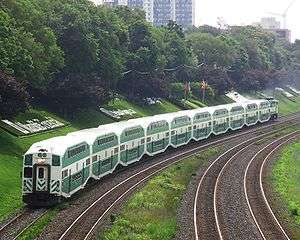
Between 1967 and 2013, the brand and color that has adorned each of its train, buses, and other property generally remained unchanged.[94] It also matched the shade of green used on signs for highways in Ontario. In July 2013, GO Transit updated its look to a two-tone color scheme.[95]
Gotham green
| Gotham green | |
|---|---|
| Hex triplet | #00573F |
| sRGBB (r, g, b) | (0, 87, 63) |
| CMYKH (c, m, y, k) | (91, 14, 78, 60) |
| HSV (h, s, v) | (163°, 100%, 34.1%) |
| Source | [96] |
| ISCC–NBS descriptor | Dark yellowish green |
| B: Normalized to [0–255] (byte) H: Normalized to [0–100] (hundred) | |
Gotham green is the official color of the New York Jets as of 4 April 2019. The name is a reference to one of the Nicknames of New York City.
Hunter green
| Hunter green | |
|---|---|
| Hex triplet | #355E3B |
| sRGBB (r, g, b) | (53, 94, 59) |
| CMYKH (c, m, y, k) | (75, 0, 75, 75) |
| HSV (h, s, v) | (120°, 45%, 45%) |
| Source | ISCC-NBS #137[97] |
| ISCC–NBS descriptor | Dark yellowish green |
| B: Normalized to [0–255] (byte) H: Normalized to [0–100] (hundred) | |
Hunter green is a color that is a representation of the color worn by hunters in the 19th century. Most hunters began wearing the color olive drab instead of hunter green about the beginning of the 20th century.[98] Some hunters still wear hunter green clothing or hunter green bandanas.
The first recorded use of hunter green as a color name in English was in 1892.[99]
Hunter green has been the official primary color of the Green Bay Packers since 1957, the New York Jets from 1998 to 2019, one of the two official colors of Ohio University and Oswego State, and one of the two official colors of the Phi Kappa Psi fraternity.
In the bandana code of the gay leather subculture, a hunter green bandana, if worn on the left, indicates that one is a leather daddy, whereas if a hunter green bandana is worn on the right, it indicates that one is looking for a leather daddy, i.e., looking for a daddy-boy relationship.[100][101][102] The color displayed at upper right matches the color that is used in the bandana code.
Prison uniforms issued by the New York State Department of Corrections and Community Supervision are colored hunter green.[103]
India green
| India green | |
|---|---|
| Hex triplet | #138808 |
| sRGBB (r, g, b) | (19, 136, 8) |
| CMYKH (c, m, y, k) | (100, 0, 70, 30) |
| HSV (h, s, v) | (115°, 94%, 53%) |
| Source | Vexillological[104] |
| ISCC–NBS descriptor | Deep yellowish green |
| B: Normalized to [0–255] (byte) H: Normalized to [0–100] (hundred) | |
India green, the color of the lower band of the National Flag of India, represents fertility and prosperity.
Islamic green
| Islamic green | |
|---|---|
| Hex triplet | #009000 |
| sRGBB (r, g, b) | (0, 144, 0) |
| CMYKH (c, m, y, k) | (100, 0, 100, 44) |
| HSV (h, s, v) | (120°, 100%, 28%) |
| Source | Encycolorpedia[105] |
| ISCC–NBS descriptor | Vivid yellowish green |
| B: Normalized to [0–255] (byte) H: Normalized to [0–100] (hundred) | |
The color green (Arabic: أخضر) has a number of traditional associations in Islam. In the Quran, it is associated with Islamic paradise. In the 12th century, green was chosen as dynastic color by the (Shiite) Fatimids, in contrast to the black used by the (Sunnite) Abbasids. After the Fatimid dynastic color, green remains particularly popular in Shi'ite iconography, but it is also widely used in by Sunni states. It is notably used in the flag of Saudi Arabia and flag of the Organisation of Islamic Cooperation.
Kelly green
| Kelly green | |
|---|---|
| Hex triplet | #4CBB17 |
| sRGBB (r, g, b) | (76, 187, 23) |
| CMYKH (c, m, y, k) | (59, 0, 88, 27) |
| HSV (h, s, v) | (101°, 87%, 73%) |
| Source | [Unsourced] |
| ISCC–NBS descriptor | Vivid yellowish green |
| B: Normalized to [0–255] (byte) H: Normalized to [0–100] (hundred) | |
Kelly green is an American term. The name derives from the fact that the surname Kelly, as well as the color green, are both popular in Ireland. The use of the term as a color name occurred at least as far back as March 1911 when it appeared in the Boston Globe and newspapers across the country as the new color of fashion. [106]
Midnight green
| Midnight green | |
|---|---|
| Hex triplet | #004953 |
| sRGBB (r, g, b) | (0, 73, 83) |
| CMYKH (c, m, y, k) | (100, 15, 26, 70) |
| HSV (h, s, v) | (187°, 100%, 33%) |
| Source | [107] |
| ISCC–NBS descriptor | Dark bluish green |
| B: Normalized to [0–255] (byte) H: Normalized to [0–100] (hundred) | |
Midnight green (sometimes called Eagle green) is the official primary color of the Philadelphia Eagles of the National Football League.
MSU green
| MSU green | |
|---|---|
| Hex triplet | #18453B |
| sRGBB (r, g, b) | (24, 69, 59) |
| CMYKH (c, m, y, k) | (82, 0, 64, 70) |
| HSV (h, s, v) | (111°, 116%, 44%) |
| Source | MSU Brand Guide[108] |
| ISCC–NBS descriptor | Very dark green |
| B: Normalized to [0–255] (byte) H: Normalized to [0–100] (hundred) | |
Green and white are the primary school colors representing Michigan State University. The university board of trustees officially standardized MSU green as part of a larger university branding effort, replacing a lighter green (PMS 341) used from 1997–2010. The official color was chosen based on the traditional darker Spartan green found on the original university varsity letter jackets and marching band jackets. The official green of Michigan State University is represented by Pantone Matching System ink color 567 (PMS 567).
Pakistan green
| Pakistan green | |
|---|---|
| Hex triplet | #01411C |
| sRGBB (r, g, b) | (1, 65, 28) |
| CMYKH (c, m, y, k) | (98, 0, 57, 75) |
| HSV (h, s, v) | (145°, 99%, 26%) |
| Source | [Unsourced] |
| ISCC–NBS descriptor | Deep yellowish green |
| B: Normalized to [0–255] (byte) H: Normalized to [0–100] (hundred) | |
Pakistan green is a shade of dark green, used in web development and graphic design. It is also the background color of the national flag of Pakistan. It is almost identical to the HTML/X11 dark green in sRGB and HSV values.
Paris green
| Paris green | |
|---|---|
| Hex triplet | #50C878 |
| sRGBB (r, g, b) | (80, 200, 120) |
| CMYKH (c, m, y, k) | (60, 0, 40, 22) |
| HSV (h, s, v) | (140°, 60%, 78%) |
| Source | [Unsourced] |
| ISCC–NBS descriptor | Vivid yellowish green |
| B: Normalized to [0–255] (byte) H: Normalized to [0–100] (hundred) | |
Paris green is a color that ranges from pale and vivid blue green to deeper true green. It comes from the inorganic compound copper (II) acetoarsenite and was once a popular pigment in artists' paints.
Persian green
| Persian green | |
|---|---|
| Hex triplet | #00A693 |
| sRGBB (r, g, b) | (0, 166, 147) |
| CMYKH (c, m, y, k) | (80, 0, 22, 0) |
| HSV (h, s, v) | (135°, 75%, 60%) |
| Source | ISCC-NBS[109] |
| ISCC–NBS descriptor | Brilliant bluish green |
| B: Normalized to [0–255] (byte) H: Normalized to [0–100] (hundred) | |
Persian green is a color used in Persian pottery and Persian carpets in Iran.
The first recorded use of Persian green as a color name in English was in 1892.[110][111]
Rifle green
| Rifle green | |
|---|---|
| Hex triplet | #444C38 |
| sRGBB (r, g, b) | (68, 76, 56) |
| CMYKH (c, m, y, k) | (11, 0, 26, 70) |
| HSV (h, s, v) | (84°, 26%, 30%) |
| Source | Pantone TPX[112][113] |
| ISCC–NBS descriptor | Dark grayish olive green |
| B: Normalized to [0–255] (byte) H: Normalized to [0–100] (hundred) | |
The color rifle green is displayed at right.
The source of this color is the Pantone Textile Paper eXtended (TPX) color list, color No. 19-0419 TPX—Rifle green.[114]
The first recorded use of rifle green as a color name in English was in 1858.[115]
Rifle green is so named from the distinctive color of the uniform of rifle regiments (a form of light infantry) of a number of European armies, and is still used as such by rifle regiments in many Commonwealth armies, such as the Rifles and Royal Gurkha Rifles of the British Army and the Queen's Own Rifles of Canada.
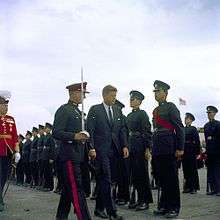
Rifle green was originally adopted by rifle regiments in the 18th century, including the famous 95th Rifles of the Napoleonic Wars. As the traditional role of riflemen was that of marksmen and skirmishers who attacked behind the cover of trees, a dark green uniform was adopted as an early form of camouflage, as opposed to the colorful uniforms worn by other soldiers of the period. The vegetable based dyes used during the 18th and early 19th centuries were not fast, frequently fading after exposure to the elements to lighter shades of green or even brown. While this had advantages in terms of reduced visibility on active service, it did not make for a smart appearance on the peace-time parade ground. Accordingly, the color of the rifleman's uniform was progressively darkened until it approached black. After 1890 the development of chemical dyes permitted the adoption of the stable shade of rifle green now worn. In the U.S. armed forces, the green beret may be worn only by soldiers awarded the Special Forces Tab, signifying they have been qualified as special forces soldiers. The special forces beret is officially designated "beret, man's, wool, rifle green, army shade 297". Previously, rifle green uniforms had been issued to Hiram Berdan's elite 1st and 2nd United States Sharpshooters during the American Civil War.
Rifle green was the official uniform color of the Canadian Forces (CF) after unification; it was thereafter generally referred to as "CF green"; indeed, the service dress uniform of the day was referred to as "CF greens". After the introduction of the distinct environmental uniform (DEU), rifle green remained as the uniform color of the winter land environment DEU; a short-lived tan uniform was worn in summer. After the demise of the tans, the rifle green DEU was worn year-round. Rifle green was also the color of the uniform worn by the Northern Irish Royal Ulster Constabulary (RUC) until 2001 where the RUC was renamed the PSNI and while the uniform color remained the same, terminology changed to "bottle green".[116]
Rifle green is 19–0419 TPX in the Pantone palette, or hex code #444C38 in the sRGB color space, as shown above.
Russian green
| Russian green | |
|---|---|
| Hex triplet | #679267 |
| sRGBB (r, g, b) | (103, 146, 103) |
| CMYKH (c, m, y, k) | (30, 0, 30, 43) |
| HSV (h, s, v) | (120°, 30%, 57%) |
| Source | ISCC-NBS[117][118] |
| ISCC–NBS descriptor | Moderate yellowish green |
| B: Normalized to [0–255] (byte) H: Normalized to [0–100] (hundred) | |
The color Russian green is displayed at right.
The first recorded use of Russian green as a color name in English was in the 1830s (exact year uncertain).[119] The term appears to refer to the medium shade of green worn by most regiments of the Imperial Russian Army from 1700 to 1914.
Sacramento State green
| Sacramento State green | |
|---|---|
| Hex triplet | #043927 |
| sRGBB (r, g, b) | (0, 78, 56) |
| CMYKH (c, m, y, k) | (89, 19, 72, 60) |
| HSV (h, s, v) | (160°, 93%, 22%) |
| Source | Sacramento State[120] |
| ISCC–NBS descriptor | Very dark yellowish green |
| B: Normalized to [0–255] (byte) H: Normalized to [0–100] (hundred) | |
In 2004, California State University, Sacramento rebranded itself as Sacramento State, while keeping the official name as the long form. In the process of rebranding a new logo was selected, and in 2005 it formalized the colors which it would use.[120]
SGBUS green
| SGBUS green | |
|---|---|
| Hex triplet | #55DD33 |
| sRGBB (r, g, b) | (85, 221, 51) |
| CMYKH (c, m, y, k) | (61.5, 0, 76.9, 13.3) |
| HSV (h, s, v) | (108°, 76.9%, 86.7%) |
| Source | HTML/CSS |
| ISCC–NBS descriptor | Vivid yellowish green |
| B: Normalized to [0–255] (byte) H: Normalized to [0–100] (hundred) | |
SGBUS green is the color voted by the public and used by Singapore to color all its government-owned public buses.[121]
Spanish green
| Spanish green | |
|---|---|
| Hex triplet | #009150 |
| sRGBB (r, g, b) | (0, 145, 80) |
| CMYKH (c, m, y, k) | (100, 0, 100, 0) |
| HSV (h, s, v) | (153°, 100%, 57%) |
| Source | Gallego and Sanz[122] |
| ISCC–NBS descriptor | Strong yellowish green |
| B: Normalized to [0–255] (byte) H: Normalized to [0–100] (hundred) | |
Spanish green is the color that is called "verde" (the Spanish word for "green") in the Guía de coloraciones (Guide to colorations) by Rosa Gallego and Juan Carlos Sanz, a color dictionary published in 2005 that is widely popular in the Hispanophone realm.
UNT green
| UNT green | |
|---|---|
| Hex triplet | #00853E |
| sRGBB (r, g, b) | (0, 133, 62) |
| CMYKH (c, m, y, k) | (100, 0, 53, 48) |
| HSV (h, s, v) | (148°, 100%, 52%) |
| Source | University of North Texas Identity Guide[123] |
| B: Normalized to [0–255] (byte) H: Normalized to [0–100] (hundred) | |
UNT green is one of three official colors used by the University of North Texas. It is the primary color that appears on branding and promotional material produced by and on behalf of the university.[123]
UP forest green
| UP forest green | |
|---|---|
| Hex triplet | #014421 |
| sRGBB (r, g, b) | (1, 68, 33) |
| CMYKH (c, m, y, k) | (89, 44, 97, 52) |
| HSV (h, s, v) | (149°, 99%, 27%) |
| Source | University of the Philippines[124] |
| ISCC–NBS descriptor | Very dark yellowish green |
| B: Normalized to [0–255] (byte) H: Normalized to [0–100] (hundred) | |
At the right is one of the official colors used by the University of the Philippines, designated as "UP forest green". It is based on the approved color specifications to be used for the seal of the university.[124]
See also
References
- "W3C TR CSS3 Color Module, HTML4 color keywords". W3.org. Retrieved 13 June 2011.
- The New Encyclopædia Britannica. Chicago: Encyclopædia Britannica, 2002. ISBN 0-85229-787-4
- "Retsof online version of ISCC-NBS Dictionary of Colo(u)r Names - Aa through Az". web.archive.org. 26 December 2012.
- The color displayed in the color box above matches the color called artichoke in the 1930 book by Maerz and Paul A Dictionary of Color New York:1930 McGraw-Hill; the color artichoke green is displayed on page 63, Plate 20, Color Sample B2.
- Maerz and Paul A Dictionary of Color New York:1930 McGraw-Hill Page 189; Color Sample of Artichoke Green: Page 63 Plate 20 Color Sample B2
- "PANTONE 18-0125 TPX Artichoke Green". Pantone. Retrieved 27 February 2016.
- Maerz and Paul A Dictionary of Color New York:1930 McGraw-Hill Page 189
- Bilik, Yan. "Dictionnaire des noms de couleurs". Pourpre.com (in French).
- The color displayed in the color box above matches the color called fern green in the 1930 book by Maerz and Paul A Dictionary of Color New York:1930 McGraw-Hill; the color fern green is displayed on page 65, Plate 21, Color Sample F5.
- Maerz and Paul A Dictionary of Color New York:1930 McGraw-Hill Page 195; color sample of Fern Green: Page 65 Plate 21 Color Sample F5
- "SVG Color Keywords, CSS3 Color Module, W3C Candidate Recommendation 14 May 2003". W3C. Retrieved 6 January 2007.
- Maerz and Paul A Dictionary of Color New York:1930 McGraw-Hill Page 195; color sample of Jungle Green: Page 69 Plate 23 Color Sample L6
- Maerz and Paul A Dictionary of Color New York:1930 McGraw-Hill Page 201; color sample of Jungle Green: Page 87 Plate 32 Color Sample L12 Note: The Color Sample shown as Jungle Green in Maerz and Paul is the color shown in the article on "jungle green" as dark jungle green.
- The color displayed in the color box above matches the color called laurel green in the 1930 book by Maerz and Paul A Dictionary of Color New York:1930 McGraw-Hill; the color laurel green is displayed on page 67, Plate 22, Color Sample L1.
- Maerz and Paul A Dictionary of Color New York:1930 McGraw-Hill Page 197; color sample of Laurel Green: Page 67 Plate 22 Color Sample L1. The color displayed in the color box above as "laurel green" matches the color shown in the color sample in Maerz and Paul
- Maerz and Paul A Dictionary of Color New York: 1930 McGraw-Hill; The index refers to Plate 20 Color Sample J1 as Lime Green; this color is shown on Plate 20 as being halfway between yellow-green (the old name for the color that is now called chartreuse green) and yellow on the color wheel.
- "Color Conversion Tool set to hex code of color #BFFF00 (Lime)". Web.forret.com. Archived from the original on 1 April 2012. Retrieved 8 June 2010.
- "ISCC-NBS". Archived from the original on 19 October 2017. Retrieved 22 November 2012.
- Forret, Peter. "Convert RGB: #FF6600 @ toolstud.io". toolstud.io.
- The source of this color is: ISCC-NBS Dictionary of Color Names (1955)--Color Sample of Mint Leaf (color sample #140).
- Maerz and Paul A Dictionary of Color New York:1930 McGraw-Hill Page 199; color sample of Mint: Page 81 Plate 29 Color Sample L10
- The color displayed in the color box above matches the color called moss green in the 1930 book by Maerz and Paul A Dictionary of Color New York:1930 McGraw-Hill; the color moss green is displayed on page 65, Plate 21, Color Sample L2.
- Maerz and Paul A Dictionary of Color New York:1930 McGraw-Hill Page 199; Color Sample of Moss Green: Page 65 Plate 21 Color Sample L2
- "Dark moss green / #4a5d23 Hex Color Code". Encycolorpedia.
- Color sample #164 on the ISCC-NBS color list is that tone of myrtle green which matches the color sample of myrtle green in the 1930 book A Dictionary of Color by Maerz and Paul (see color sample of Myrtle Green on Page 85 Plate 31 Color Sample L1).
- Maerz and Paul A Dictionary of Color New York:1930 McGraw-Hill Page 199; Color Sample of Myrtle Green: Page 85 Plate 31 Color Sample L1
- Maerz and Paul A Dictionary of Color New York:1930 McGraw-Hill Page 190; Color Sample of Pine Tree: Page 85 Plate 31 Color Sample L6
- Overview of all RAL Classic colours. RAL gemeinnützige GmbH. Accessed January 2016.
- Nikolas Davies, Erkki Jokiniemi (2008). Dictionary of Architecture and Building Construction. Amsterdam; Boston; London: Elsevier/Architectural Press. ISBN 9780750685023.
- Vergnaud, Armand Denis; Toussaint, G. Alvar (1874). A Practical Treatise on the Manufacture of Colors for Painting: Comprising the Origin, Definition, and Classification of Colors; the Treatment of the Raw Materials Etc. H.C. Baird. p. 535. Retrieved 2 August 2018.
sap green.
- MacEvoy, Bruce. "handprint : colormaking attributes". www.handprint.com. Retrieved 2 August 2018.
- "Sap Green". Bob Ross.com. Retrieved 2 August 2018.
- The color displayed in the color box above matches the color called shamrock in the 1930 book by Maerz and Paul A Dictionary of Color New York:1930 McGraw-Hill; the color shamrock is displayed on page 65, Plate 21, Color Sample C9.
- Nicola Gordon Bowe. "Symbols of Ireland". .gov.ie. Archived from the original on 14 June 2011. Retrieved 13 June 2011.
- Maerz and Paul A Dictionary of Color New York:1930 McGraw-Hill Page 204; Color Sample of Shamrock: Page 65 Plate 21 Color Sample C9
- Guidelines for Use of the National Flag , published by the Irish Government and the Department of the Taoiseach (.gov.ie). Document retrieved 3 April 2018
- Library. "National Flag". www.taoiseach.gov.ie. Retrieved 3 April 2018.
- "California Code, Government Code – GOV § 420". FindLaw. Retrieved 3 April 2018.
- "Tea green / Caparol 28/11 / #d0f0c0 Hex Color Code". encycolorpedia.com.
- I. Patterson, A Dictionary of Colour, Thorogood, 2003, ISBN 1-85418-247-1, page 381. "tea green – The greyish green of green tea."
- Maerz and Paul A Dictionary of Color New York:1930 McGraw-Hill Page 205; Color Sample of Tea Green: Page 65 Plate 21 Color Sample C2
- The color displayed in the color box above matches the color called emerald green in the 1930 book by Maerz and Paul A Dictionary of Color New York:1930 McGraw-Hill; the color emerald green is displayed on page 75, Plate 26, Color Sample J10.
- St. Clair, Kassia (2016). The Secret Lives of Colour. London: John Murray. pp. 220–221. ISBN 9781473630819. OCLC 936144129.
- Maerz and Paul A Dictionary of Color New York:1930 McGraw-Hill Page 194; Color Sample of Emerald: Page 75 Plate 26 Color Sample J10
- Chandraseekaran, Rajiv Imperial Life in the Emerald City: Inside Iraq's Green Zone 2007
- Regan, Trish (22 January 2009). "Pot growers thrive in Northern California: Cash crop now accounts for two-thirds of Mendocino County economy". CNBC.
- "Pigments through the Ages - History - Emerald green". www.webexhibits.org. Retrieved 1 March 2020.
- "Emerald Green or Paris Green, the Deadly Regency Pigment". Jane Austen's World. 5 March 2010. Retrieved 1 March 2020.
- Wright, Jennifer (17 March 2017). "The History of Green Dye Is a History of Death". Racked. Retrieved 1 March 2020.
- The color in the color box above matches the color called green earth in Derwent colored pencils.
- Green earth Colourlex. Retrieved 29 August 2016.
- Green earth. Pigments through the Ages. www.webexhibits.com. Retrieved 29 August 2016.
- "Colour Chart – Hooker's Green". Winsor & Newton. Retrieved 29 September 2011.
- St. Clair, Kassia (2016). The Secret Lives of Colour. London: John Murray. p. 81. ISBN 9781473630819. OCLC 936144129.
- Maerz and Paul A Dictionary of Color New York:1930 McGraw-Hill Page 162—Discussion of color Jade Green
- Maerz and Paul A Dictionary of Color New York:1930 McGraw-Hill Page 197
- The color displayed in the color box above matches the color called malachite in the 1930 book by Maerz and Paul A Dictionary of Color New York:1930 McGraw-Hill; the color malachite green is displayed on page 79, Plate 28, Color Sample A9.
- Maerz and Paul A Dictionary of Color New York:1930 McGraw-Hill Page 198; Color Sample of Malachite Green: Page 79 Plate 28 Color Sample A9
- "X11 rgb.txt". XFree86. Archived from the original on 7 November 2015. Retrieved 5 February 2008.
- "W3C TR CSS3 Color Module, HTML4 color keywords". W3.org. Retrieved 8 June 2010.
- "Tintbooks – Get Accurate CMYK Color Results For Your Printing Projects". Tintbook.com. 18 March 2007. Archived from the original on 10 March 2007.
- The sRGB values are taken by converting the NCS color 2060-G using the "NCS Navigator" tool at the NCS website.
- Munsell Color Wheel
- "Pantone TPX Pantone Color Finder—Type the word "Green" into the indicated window on the Pantone Color Finder and the color will appear. There are six versions, all with the same color codes—C, EC, HC, PC, U, and UP". Pantone.
- Diner, Web. "restaurant web design,restaurant website design,restaurant graphic design,restaurant marketing". Webdiner.
- "Worldchanging – Evaluation + Tools + Best Practices: Bright Green, Light Green, Dark Green, Gray: The New Environmental Spectrum". worldchanging.com. Archived from the original on 12 January 2016.
- "Dark green / #013220 Hex Color Code". Encycolorpedia.
- "Dark pastel green / #03c03c Hex Color Code". Encycolorpedia.
- Maerz and Paul A Dictionary of Color New York:1930 McGraw-Hill Page 194; Color Sample of Erin Page 81 Plate 29 Color Sample F12; A deep tone of the color Erin is shown as lying half way between a deep tone of green and a deep tone of the color that is now called spring green, on the bottom row of color samples on the color plate, which represent the deeper tones of the colors between green and the color now called spring green.
- The color displayed in the color box above matches the color called harlequin in the 1930 book by Maerz and Paul A Dictionary of Color New York:1930 McGraw-Hill; the color harlequin is displayed on page 57, Plate 17, Color Sample K11.
- Maerz, Aloys John; Paul, Morris Rea (1930). "A Dictionary of Color" (1st ed.). New York: McGraw-Hill: 57 plate 17 color sample K11; p. 196. OCLC 1150631. Cite journal requires
|journal=(help) - Paterson, Ian (2003). A Dictionary of Colour (1st paperback ed.). London: Thorogood Publishing (published 2004). p. 198. ISBN 1-85418-375-3. OCLC 60411025.
- "Archived copy". Archived from the original on 11 November 2012. Retrieved 18 November 2012.CS1 maint: archived copy as title (link)
- "Army green / #4b5320 Hex Color Code". Encycolorpedia.
- "Bangladesh green / #006a4e Hex Color Code". encycolorpedia.com.
- Maerz and Paul A Dictionary of Color New York:1930 McGraw-Hill Page 190; Color Sample of Bottle Green: Page 85 Plate 31 Color Sample J7
- "Uniform policy". South Sydney High School. Retrieved 3 May 2016.
- People's Republic of Bangladesh Flag Rules, 1972 (Revised up to 2005) Archived 2009-03-06 at the Wayback Machine, Government of Bangladesh, Cabinet Division.
- "Archived copy". Archived from the original on 5 March 2017. Retrieved 4 March 2017.CS1 maint: archived copy as title (link)
- Maerz and Paul A Dictionary of Color New York:1930 McGraw-Hill--Discussion of the color Brunswick Green Page 151
- Maerz and Paul A Dictionary of Color New York:1930 McGraw-Hill Page 191; Color Sample of Brunswick Green (deep): Page 71 Plate 24 Color Sample A12
- Maerz and Paul A Dictionary of Color New York:1930 McGraw-Hill Page 194; the color sample for English Green is noted as being the same as for Brunswick Green (deep): Page 71 Plate 24 Color Sample A12
- (unknown) (1913). Modern Artist's Pigments Archived 11 March 2008 at the Wayback Machine, retrieved on 13 December 2005.
- "Colors". Castleton University.
- "Celadon / #ace1af Hex Color Code". Encycolorpedia.
- Gompertz, G.St.G.M., Chinese Celadon Wares, p. 21, 1980 (2nd edn.), Faber & Faber, ISBN 057118003521
- St. Clair, Kassia (2016). The Secret Lives of Colour. London: John Murray. pp. 232–233. ISBN 9781473630819. OCLC 936144129.
- Dewar, Richard. (2002). Stoneware. Philadelphia: University of Pennsylvania Press. ISBN 0-8122-1837-X, p. 42.
- Vainker, S.J., Chinese Pottery and Porcelain, 1991, British Museum Press, 9780714114705, pp.53–55
- "Dartmouth Brand Guide" (PDF). Dartmouth College. Archived from the original (PDF) on 22 January 2016. Retrieved 21 November 2015.
- Ask Dartmouth Home >. "Ask Dartmouth". Ask.dartmouth.edu. Retrieved 13 June 2011.CS1 maint: extra punctuation (link)
- Mindjunker http://www.mindjunker.com/random/10-unusual-color-names-youve-never-heard-of.html. Missing or empty
|title=(help) - "Metrolinx" (PDF). Legislative Assembly of Ontario. Retrieved 19 August 2012.
- "The design history of the GO Transit logo" (PDF). Retrieved 19 August 2012.
- Gillis, Wendy (16 July 2013). "GO Transit trains and buses get a makeover". Toronto Star. Retrieved 20 July 2014.
- "New York Jets Colors Hex, RGB, and CMYK". Team Color Codes. 22 May 2017.
- "ISCC-NBS #137". Archived from the original on 22 November 2012.
- Maerz and Paul A Dictionary of Color New York:1930 McGraw-Hill Page 162—Discussion of color Hunter Green
- Maerz and Paul A Dictionary of Color New York:1930 McGraw-Hill Page 196; Color Sample of Hunter Green Page Plate 24 Color Sample C11—Hunter Green
- Andrews, Vincent (2010), The Leatherboy Handbook, The Nazca Plains Corp., ISBN 978-1-61098-046-3
- Hankycode on gaycitiusa.com Archived 2007-12-06 at the Wayback Machine access date 2012-03-30
- Hankycode on leathernjonline.com access date 2010-03-30
- Beam, Christopher (3 December 2010). "When did prisoners start dressing in orange?". Explainer (column). Slate. Retrieved 31 October 2017.
- "Archived copy". Archived from the original on 27 August 2016. Retrieved 1 June 2015.CS1 maint: archived copy as title (link)
- "Islamic green / Caparol 34/05 / #009000 Hex Color Code". Encycolorpedia.
- Boston Globe 1911, – retrieved from Newspapers.com.
- "Team Colors – NFL". Ssur.org. Archived from the original on 16 March 2012. Retrieved 13 June 2011.
- "The MSU Brand – Design and Visual Identity". Michigan State University.
- "ISCC-NBS". Archived from the original on 30 July 2017. Retrieved 6 March 2008.
- Maerz and Paul A Dictionary of Color New York:1930 McGraw-Hill Page 201; color sample of Persian green: Page 85 Plate 31 Color Sample H7
- The source of this color is the ISCC-NBS Dictionary of Color Names (1955), a color dictionary used by stamp collectors to identify the colors of stamps, now on the Internet—see sample of the color Persian green (color sample #159) displayed on indicated web page: Archived 30 July 2017 at the Wayback Machine.
- Type the words "Rifle green" into the indicated window on the Pantone Color Finder and the color will appear. http://www.pantone.com/pages/pantone/colorfinder.aspx
- The color displayed in the color box above matches the color called Rifle green in the 1930 book by Maerz and Paul A Dictionary of Color New York:1930 McGraw-Hill; the color Rifle green is displayed on page 87, Plate 32, Color Sample A2.
- "Pantone TPX Pantone Color Finder—Type the words "Rifle green" into the indicated window on the Pantone Color Finder and the color will appear". pantone.com.
- Maerz and Paul A Dictionary of Color New York:1930 McGraw-Hill Page 203; Color Sample of Russian Green: Page 87 Plate 32 Color Sample A2
- "Patten Report". BBC News.
- "ISCC NBS". Archived from the original on 19 October 2017. Retrieved 22 November 2012.
- The color displayed in the color box above (color sample #136 on the ISCC-NBS color list) matches the color called Russian green in the 1930 book by Maerz and Paul A Dictionary of Color New York:1930 McGraw-Hill; the color Russian green is displayed on page 83, Plate 30, Color Sample D7.
- Maerz and Paul A Dictionary of Color New York:1930 McGraw-Hill Page 203; Color Sample of Russian Green: Page 83 Plate 30 Color Sample D7
- "Sacramento State Brand Book" (PDF). Sacramento State. Retrieved 10 November 2015.
- "'Lush Green' picked as colour for new Singapore buses".
- Gallego, Rosa; Sanz, Juan Carlos (2005). Guía de coloraciones (Gallego, Rosa; Sanz, Juan Carlos (2005). Guide to Colorations) Madrid: H. Blume. ISBN 84-89840-31-8
- "Color | UNT Identity Guide". University of North Texas. Retrieved 8 December 2017.
- "UP Brandbook" (PDF).
